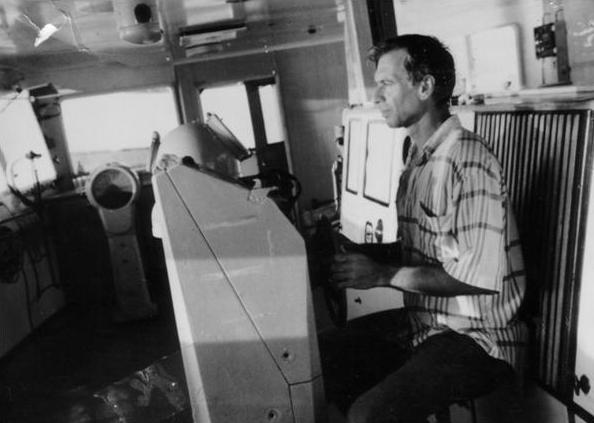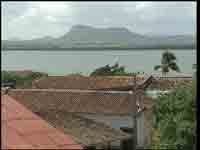On Board “Seaweed”
From “Cuba at Sea” by Ron Ridenour

HAVANA TIMES, Jan 8 – Incipient rays of sun rose over our port bow illuminating the aqua Atlantic. “015 starboard”, commands the first mate, Sigi. “Aye, 015 degrees starboard,” I reply from the helm as I steer the Seaweed to a new course.
“Fifteen degrees starboard. Course now 1 5 0 degrees,” I declare when the compass registers the new bearing. This medium size Soviet-built tanker is sailing at 12 knots.
“Steady as she goes,” Sigi responds.
At the burst of brightness, the stocky, balding and graying seaman and I stand side by side in the pilot house. Six decks above water line, we watch sardine-size flying fish skipping just above the sea. Following their trajectory, we see the silhouette of a chair-shaped, low mountain.
“There it is, la Silla de Gibara, exclaims a smiling Sigi, “the first Cuban soil Columbus spied.”
We were passing the Chair of Gibara, jutting alone above the Bay of Bariay in Holguín province. We were heading southeast toward Santiago de Cuba where we would load crude oil. On October 27, 1492, Christopher Columbus and his sailors gazed upon this bay and were the first Europeans to see Cuba. He described the turquoise bay and verdant coastline, which he thought was Japan, this way: “This land is the most beautiful eyes have seen”.
Just two weeks before Columbus had “discovered” America when he landed on Guanahaní Island, known today as San Salvador Island, part of the Bahamas. Columbus thought he had found India.

Upon landing in Cuba, Columbus wrote in his log: “I will speak to the King and see if I can get the gold that I hear he wears.” The native inhabitants Columbus and his men encountered, the Taínos, called their island Colba-meaning rock, mountain and cave in their language. The Spanish wrote it as Cuba. They came to know it as the Key to the New World. To poets it is the Pearl of the Antilles. The Yankees eventually followed Columbus´ greedy quest for gold by making Cuba the Montecarlo of the Caribbean.
Five centuries later, with the commemoration of Columbus´ “discovery” still fresh, I was sailing around the independent nation hoping to understand this unique society by inhaling its beauty and dilemmas from the sea. In the course of two years, I made the bojeo and cabotaje (1), and then I sailed on Cuban container ships to Europe and return.
In all, I sailed nearly half-a-year. I was the first U.S. citizen to sail on revolutionary Cuba’s ships. The only non-Cubans to sail were technical workers from the previous Comecon lands. Cuba has no passenger ships so it took special permission to be aboard tankers and freighters. I worked with the men in order to learn and write about Cuba from the sea.
Bariay´s shoreline is nearly barren of life and structures now. There are only a handful of small, rickety houses, mostly summer shacks for fishermen who live in nearby Gibara. A simple plaque marks the spot where Columbus sailed into the narrow bay. I swam in its muddy waters, feeling historically connected.
When I sailed with Sigi, he was already a veteran seaman of 55 years. An erudite man, he loved to read and debate about history and historical figures, such as Columbus.
“Columbus and all his low-breed cohorts were not discoverers of America. They were simply vulgar invaders. America was already inhabited by many peoples, who had migrated from Asia. They had social organizations, economies and cultures. Columbus and his followers were brutal, rapacious invaders. They came with the cross and the sword to plunder in the name of civilization. What they left us-we, who were bred here from their raping and enslavements, such as my forefathers both from Africa and native Americans-is their egoism, ambitions and indifference to others. They left us their social and psychological misery, and half a millennium later this is still affecting our peoples.”
I was on watch with Sigi. He had shown me how to steer the helm, and instructed me in the sonar and charting courses, which were beyond my comprehension. Sigi was mostly a self-taught man, who had worked many jobs in his lifetime and fought battles during the revolution, although he never managed to join up with the July 26 Movement. He was always frank with me and a kidder too. On one of several voyages together he told me what he thought of life at sea.
“I’ve never liked seamanship, though I’m still a merchant marine after 25 years. I got into it because it was a Communist party priority. It was necessary to strengthen our shipping capacity, which was next to nil before the revolutionary triumph. Many compañeros (2) took jobs because the country needed them. We were never made to work where we didn’t want to. We were asked and if we agreed then we joined up.
“Well, I learned something new, saw many places and people. The first ship I was shown shocked me it was so huge. I’d never seen a ship up close and didn’t care much for it but I launched into this new world from my farming background. After a while, they made me an instructor.
“Later, the shipping company gave me a task of investigating new recruits. I never went into the merchant marine academy but because of experience at sea, and my own studying, I became an officer. I went through the ranks to pilot, guiding ships in an out of harbor. Today, I have my captain’s license but no ship. Continuing as first mate makes no difference to me; it’s just a job. I’m no romantic. I love nature but on land. The mountains are what attract me, like la Silla de Gibara, and especially the Sierra Maestra we will soon be passing. I grew up alongside those majestic mountains. The sea is dull in comparison.
“Sure, I can feel some pride in that I’m contributing to the economy, to my country, but I’m only transporting others’ sweat. I don’t produce anything. I don’t sweat. I live a soft life as an officer. It’s almost a joy ride sailing around the island, gazing at the shoreline, the sky, the sea. It’s not like the deck hands that constantly chip away at the endless rust, or the oilers whose skin is forever greasy black. In my youth, I got more satisfaction as a volunteer doing hard physical labor than in sailing.
“But I can’t regain that sensation by cutting sugar cane for 15 days knowing that I’ve got such a comfortable life. I make 450 pesos a month basic pay because of my seniority. The first mate basic pay is 310 pesos. But with bonuses for sailing, my monthly income is up to 650 pesos; more than triple the national average wage. But I don’t knuckle down like those who cut cane. I just can’t feel that pride the sugar cane worker does when he sees a ship filled with sugar, or with crude oil bought with his labor. He can look at this ship and say, ‘There goes my sweat´.”
To purchase a copy of the book you can place an order with Amazon (www.amazon.co.uk/Cuba-at-Sea-Ron-Ridenour/dp/0906378028), Socialist Resistance (www.resistancebooks.blogspot.com/http) or write the author at Soderupvej 1, 4330 Havalsoe, Denmark.





